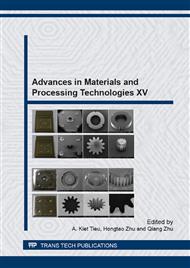p.525
p.534
p.541
p.547
p.557
p.563
p.573
p.590
p.602
Study on Functions of Chrome and Fluoride Ions in Plating Process of Tin Free Steel by Means of Cyclic Voltammetry
Abstract:
Plating solution of tin free steel (TFS) presents strong corrosion and special chemical action properties of chrome ions and fluoride ions. Electrochemistry behavior of their ions in the plating process of TFS was investigated by means of cyclic voltammetry (CV). The results show that hydrogen and oxygen evolution peaks can only be found in CV curves of the carbon anode in fluoride solution. CV curves of the carbon anode in chromium trioxide solution consist of five anodic peaks and two cathodic peaks. When fluoride ions are added into chrome ions solution, anodic peak disappears at peak potential of 1.18V. For CV curves of lead alloy anode, anodic peak can be found at peak potential of-0.2V in fluoride solution, and oxidation process is in asymmetry with reductive process in chromium trioxide solution or the mixed solution. As to CV curves of lead oxide anode, the current density of all peaks in chrome ions solution is lower compared with that of carbon anode and lead alloy anode. When fluoride ions are added into chrome ions solution, the current density of the oxidation process obviously decreases, while the absolute value of reductive process increase remarkably
Info:
Periodical:
Pages:
557-562
Citation:
Online since:
November 2013
Authors:
Price:
Сopyright:
© 2014 Trans Tech Publications Ltd. All Rights Reserved
Share:
Citation:


